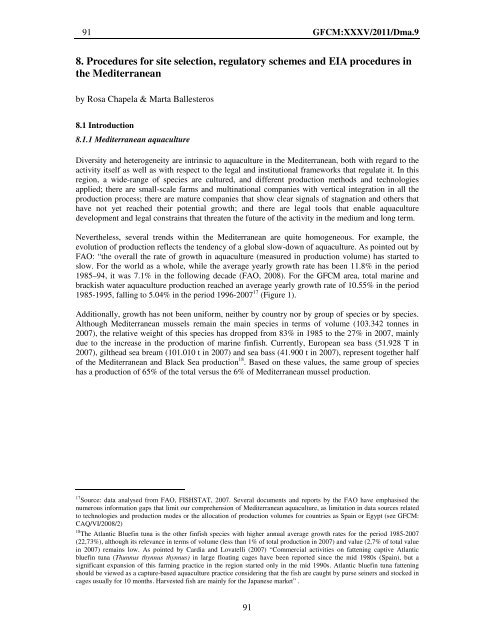Site selection and carrying capacity in Mediterranean ... - FAO Sipam
Site selection and carrying capacity in Mediterranean ... - FAO Sipam
Site selection and carrying capacity in Mediterranean ... - FAO Sipam
Create successful ePaper yourself
Turn your PDF publications into a flip-book with our unique Google optimized e-Paper software.
91 GFCM:XXXV/2011/Dma.9<br />
8. Procedures for site <strong>selection</strong>, regulatory schemes <strong>and</strong> EIA procedures <strong>in</strong><br />
the <strong>Mediterranean</strong><br />
by Rosa Chapela & Marta Ballesteros<br />
8.1 Introduction<br />
8.1.1 <strong>Mediterranean</strong> aquaculture<br />
Diversity <strong>and</strong> heterogeneity are <strong>in</strong>tr<strong>in</strong>sic to aquaculture <strong>in</strong> the <strong>Mediterranean</strong>, both with regard to the<br />
activity itself as well as with respect to the legal <strong>and</strong> <strong>in</strong>stitutional frameworks that regulate it. In this<br />
region, a wide-range of species are cultured, <strong>and</strong> different production methods <strong>and</strong> technologies<br />
applied; there are small-scale farms <strong>and</strong> mult<strong>in</strong>ational companies with vertical <strong>in</strong>tegration <strong>in</strong> all the<br />
production process; there are mature companies that show clear signals of stagnation <strong>and</strong> others that<br />
have not yet reached their potential growth; <strong>and</strong> there are legal tools that enable aquaculture<br />
development <strong>and</strong> legal constra<strong>in</strong>s that threaten the future of the activity <strong>in</strong> the medium <strong>and</strong> long term.<br />
Nevertheless, several trends with<strong>in</strong> the <strong>Mediterranean</strong> are quite homogeneous. For example, the<br />
evolution of production reflects the tendency of a global slow-down of aquaculture. As po<strong>in</strong>ted out by<br />
<strong>FAO</strong>: “the overall the rate of growth <strong>in</strong> aquaculture (measured <strong>in</strong> production volume) has started to<br />
slow. For the world as a whole, while the average yearly growth rate has been 11.8% <strong>in</strong> the period<br />
1985–94, it was 7.1% <strong>in</strong> the follow<strong>in</strong>g decade (<strong>FAO</strong>, 2008). For the GFCM area, total mar<strong>in</strong>e <strong>and</strong><br />
brackish water aquaculture production reached an average yearly growth rate of 10.55% <strong>in</strong> the period<br />
1985-1995, fall<strong>in</strong>g to 5.04% <strong>in</strong> the period 1996-2007 17 (Figure 1).<br />
Additionally, growth has not been uniform, neither by country nor by group of species or by species.<br />
Although <strong>Mediterranean</strong> mussels rema<strong>in</strong> the ma<strong>in</strong> species <strong>in</strong> terms of volume (103.342 tonnes <strong>in</strong><br />
2007), the relative weight of this species has dropped from 83% <strong>in</strong> 1985 to the 27% <strong>in</strong> 2007, ma<strong>in</strong>ly<br />
due to the <strong>in</strong>crease <strong>in</strong> the production of mar<strong>in</strong>e f<strong>in</strong>fish. Currently, European sea bass (51.928 T <strong>in</strong><br />
2007), gilthead sea bream (101.010 t <strong>in</strong> 2007) <strong>and</strong> sea bass (41.900 t <strong>in</strong> 2007), represent together half<br />
of the <strong>Mediterranean</strong> <strong>and</strong> Black Sea production 18 . Based on these values, the same group of species<br />
has a production of 65% of the total versus the 6% of <strong>Mediterranean</strong> mussel production.<br />
17 Source: data analysed from <strong>FAO</strong>, FISHSTAT, 2007. Several documents <strong>and</strong> reports by the <strong>FAO</strong> have emphasised the<br />
numerous <strong>in</strong>formation gaps that limit our comprehension of <strong>Mediterranean</strong> aquaculture, as limitation <strong>in</strong> data sources related<br />
to technologies <strong>and</strong> production modes or the allocation of production volumes for countries as Spa<strong>in</strong> or Egypt (see GFCM:<br />
CAQ/VI/2008/2)<br />
18 The Atlantic Bluef<strong>in</strong> tuna is the other f<strong>in</strong>fish species with higher annual average growth rates for the period 1985-2007<br />
(22,73%), although its relevance <strong>in</strong> terms of volume (less than 1% of total production <strong>in</strong> 2007) <strong>and</strong> value (2,7% of total value<br />
<strong>in</strong> 2007) rema<strong>in</strong>s low. As po<strong>in</strong>ted by Cardia <strong>and</strong> Lovatelli (2007) “Commercial activities on fatten<strong>in</strong>g captive Atlantic<br />
bluef<strong>in</strong> tuna (Thunnus thynnus thynnus) <strong>in</strong> large float<strong>in</strong>g cages have been reported s<strong>in</strong>ce the mid 1980s (Spa<strong>in</strong>), but a<br />
significant expansion of this farm<strong>in</strong>g practice <strong>in</strong> the region started only <strong>in</strong> the mid 1990s. Atlantic bluef<strong>in</strong> tuna fatten<strong>in</strong>g<br />
should be viewed as a capture-based aquaculture practice consider<strong>in</strong>g that the fish are caught by purse se<strong>in</strong>ers <strong>and</strong> stocked <strong>in</strong><br />
cages usually for 10 months. Harvested fish are ma<strong>in</strong>ly for the Japanese market” .<br />
91
















